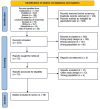Enhancing functional motor outcomes in chronic stroke: A systematic review of the growing role of non-invasive brain stimulation
- PMID: 40720525
- PMCID: PMC12303356
- DOI: 10.1371/journal.pone.0327583
Enhancing functional motor outcomes in chronic stroke: A systematic review of the growing role of non-invasive brain stimulation
Abstract
Introduction: Non-invasive brain stimulation (NIBS) promotes functional recovery by enhancing neuroplasticity and reorganizing brain networks. It is hypothesized that transcranial magnetic stimulation (TMS), repetitive transcranial magnetic stimulation (rTMS), or intermittent θ-burst stimulation (i-TBS) as well as trans direct current stimulation (tDCS) can modulate synaptic connectivity, through magnetic or electric stimuli, directly on the brain area. This systematic review aims to address the lack of comprehensive syntheses focusing on the comparative effectiveness of NIBS techniques, including tDCS, rTMS, and iTBS, on distinct motor domains (upper limb, lower limb, and vocal/swallowing functions) in chronic stroke patients.
Evidence acquisition: A systematic search was conducted for all peer-reviewed articles published from January 2010 through September 2023, using the following databases: PubMed, Embase, Cochrane Database of Systematic Reviews, PEDro, RehabData, and Web of Science. This systematic review was performed following the recommendations of the Preferred Reporting Items for Systematic Reviews and Meta-Analyses (PRISMA) guidelines, with a registration number in the Prospective Register of Systematic Reviews (PROSPERO 2023) CRD42023458370. A total of 58 studies were included in the qualitative synthesis: 27 focused on upper limb rehabilitation, 13 on lower limb function, 13 on the combination of NIBS and robotic therapy, and 6 on vocal or swallowing functions. Most studies (78%) were randomized controlled trials. Among the NIBS techniques, tDCS showed stronger evidence for gait and balance recovery, while rTMS appeared more effective for upper limb function. Overall, the majority of studies presented a low risk of bias, although methodological issues such as inadequate randomization or blinding affected the reliability of some findings.
Conclusion: We have systematically reviewed the literature on the use of NIBS to enhance motor outcomes (upper limb, lower limb, and vocal/swallowing functions) in individuals with chronic stroke. Findings indicate that rTMS demonstrates greater efficacy in improving upper limb motor function, whereas tDCS appears to be more effective in enhancing gait and balance recover.
Copyright: © 2025 Bonanno et al. This is an open access article distributed under the terms of the Creative Commons Attribution License, which permits unrestricted use, distribution, and reproduction in any medium, provided the original author and source are credited.
Conflict of interest statement
The authors have declared that no competing interests exist.
Figures
Similar articles
-
Examining the effectiveness of motor imagery combined with non-invasive brain stimulation for upper limb recovery in stroke patients: a systematic review and meta-analysis of randomized clinical trials.J Neuroeng Rehabil. 2024 Nov 30;21(1):209. doi: 10.1186/s12984-024-01491-x. J Neuroeng Rehabil. 2024. PMID: 39616389 Free PMC article.
-
Comparative efficacy of different noninvasive brain stimulation protocols on upper-extremity motor function and activities of daily living after stroke: a systematic review and network meta-analysis.Neurol Sci. 2024 Aug;45(8):3641-3681. doi: 10.1007/s10072-024-07437-4. Epub 2024 Mar 23. Neurol Sci. 2024. PMID: 38520639
-
Non-invasive Brain Stimulation Techniques for the Improvement of Upper Limb Motor Function and Performance in Activities of Daily Living After Stroke: A Systematic Review and Network Meta-analysis.Arch Phys Med Rehabil. 2023 Oct;104(10):1683-1697. doi: 10.1016/j.apmr.2023.04.027. Epub 2023 May 26. Arch Phys Med Rehabil. 2023. PMID: 37245690
-
Can non-motor outcomes be improved in chronic stroke? A systematic review on the potential role of non-invasive brain stimulation.Brain Res. 2024 Oct 15;1841:149093. doi: 10.1016/j.brainres.2024.149093. Epub 2024 Jun 22. Brain Res. 2024. PMID: 38909976
-
Interventions for improving upper limb function after stroke.Cochrane Database Syst Rev. 2014 Nov 12;2014(11):CD010820. doi: 10.1002/14651858.CD010820.pub2. Cochrane Database Syst Rev. 2014. PMID: 25387001 Free PMC article.
References
-
- Naro A, Calabrò RS. Improving Upper Limb and Gait Rehabilitation Outcomes in Post-Stroke Patients: A Scoping Review on the Additional Effects of Non-Invasive Brain Stimulation When Combined with Robot-Aided Rehabilitation. Brain Sci. 2022;12(11):1511. doi: 10.3390/brainsci12111511 - DOI - PMC - PubMed
-
- Tikka SK, Siddiqui MA, Garg S, Pattojoshi A, Gautam M. Clinical Practice Guidelines for the Therapeutic Use of Repetitive Transcranial Magnetic Stimulation in Neuropsychiatric Disorders. Indian J Psychiatry. 2023;65(2):270–88. doi: 10.4103/indianjpsychiatry.indianjpsychiatry_492_22 - DOI - PMC - PubMed
Publication types
MeSH terms
LinkOut - more resources
Full Text Sources
Medical






